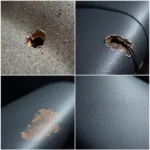Dealing with a sluggish or error-prone Windows 7 system? Don’t rush into a reinstall just yet! You can try repairing Windows 7 using CMD (Command Prompt), a powerful built-in tool. This guide provides a step-by-step approach to help you troubleshoot and fix common Windows 7 issues using CMD commands.
Understanding CMD and Its Role in Windows Repair
CMD, short for Command Prompt, acts as a direct line to your operating system, allowing you to execute commands that control various system functions. While it might seem intimidating at first, CMD offers a powerful set of tools to diagnose and repair Windows 7 issues.
Common Windows 7 Problems Solvable with CMD
Before we dive into the solutions, let’s identify some frequent Windows 7 problems that CMD can effectively address:
- Boot errors: Issues preventing Windows from starting properly.
- Corrupted system files: Essential system files damaged or missing, leading to instability.
- Disk errors: Problems with your hard drive’s file system, affecting data access.
- Malware infections: Certain malware can be removed using CMD commands.
Repairing Windows 7 with CMD: Step-by-Step Solutions
Let’s explore the solutions to these common Windows 7 issues using CMD:
1. Accessing CMD in Windows 7
- Method 1: Using the Start Menu
- Click the Start button.
- Type cmd in the search bar.
- Right-click on cmd.exe and select Run as administrator.
- Method 2: Using the Windows 7 Installation Disc
- Insert the Windows 7 installation disc.
- Restart your computer.
- Press any key when prompted to boot from the disc.
- Select your language and keyboard layout, then click Next.
- Click Repair your computer.
- Select Command Prompt from the recovery options.
2. Essential CMD Commands for Windows 7 Repair
Now that you have access to the Command Prompt, let’s look at some essential commands for repairing your Windows 7 system:
-
Bootrec.exe: This tool helps fix boot sector issues:
- bootrec.exe /fixmbr: Writes a new Master Boot Record (MBR) to the boot sector.
- bootrec.exe /fixboot: Writes a new boot sector to the system partition.
- bootrec.exe /rebuildbcd: Rebuilds the Boot Configuration Data (BCD).
-
sfc /scannow: This command scans and repairs corrupted system files:
- Type sfc /scannow and press Enter.
- Wait for the scan and repair process to complete.
-
chkdsk: Checks your hard drive for errors and attempts to fix them:
- chkdsk C: /f: Checks the C: drive (replace with the appropriate drive letter) for errors and fixes them.
3. Advanced Troubleshooting with CMD
For more complex issues, consider these advanced CMD techniques:
-
System Restore: Revert your system to a previous stable state:
- Type rstrui.exe in CMD and press Enter.
- Follow the on-screen instructions to choose a restore point.
-
Startup Repair: Automatically diagnose and repair startup issues:
-
Restart your computer and repeatedly press F8 during startup.
-
Select Repair Your Computer.
-
Choose Startup Repair from the recovery options.
-
Preventing Future Windows 7 Issues
While CMD is a valuable tool for repairing Windows 7, prevention is always better than cure. Here are some tips to keep your system running smoothly:
- Regularly update Windows: Install the latest updates to patch vulnerabilities and improve stability.
- Install a reliable antivirus: Protect your system from malware and other threats.
- Perform regular system maintenance: Use built-in tools like Disk Cleanup and Disk Defragmenter to optimize your hard drive.
cara repair windows 10 dengan cmd
Conclusion
Repairing Windows 7 with CMD offers a powerful way to troubleshoot and fix common system issues. This guide provided you with the essential steps, commands, and precautions to help restore your system to its optimal state. Remember to exercise caution while using CMD, as incorrect commands can potentially lead to data loss. If you encounter persistent problems or are unsure about using CMD, seeking professional technical assistance is always recommended.


